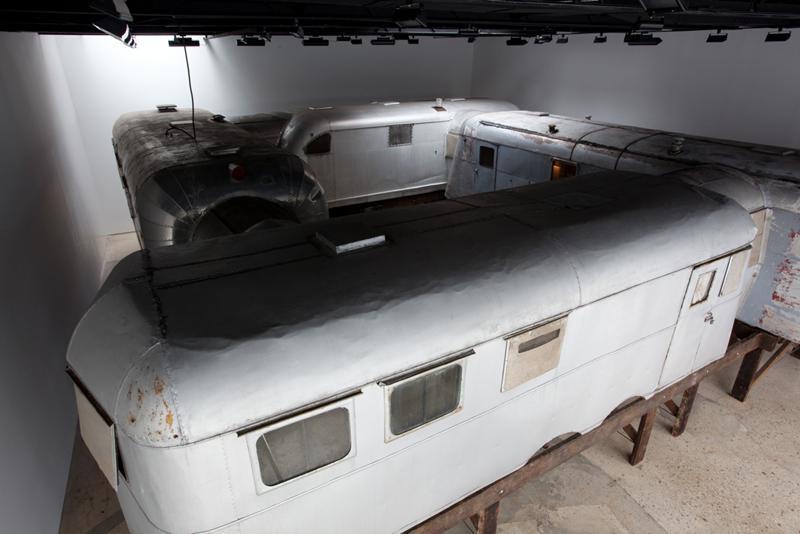
New York
Mike Nelson: Quiver of Arrows
303 Gallery
February 27–April 10, 2010
From the outside, the four vintage trailers that filled 303 Gallery presented a shabby but impenetrable front: their wheels had been removed, their ends had been welded together, and the whole thing had been raised on a rough wooden platform. Entering the installation required circling weather-beaten aluminum walls to climb a shaky wooden ramp.
Inside, it was so dim, it took a few seconds to adjust to a new environment. As they became visible, dingy interiors seemed to reinforce a faded modernist glamour, from the simple curves of the wood paneling to the aerodynamic portholes. The trailers were vamped-up wagons for a new age of American frontier exploration, and their chrome-and-wood forms spoke of a mass-marketed dream of space-age aesthetics; the cultural appeal of their archeology was evident, especially for those interested in the affective possibilities of aging architecture.
Those trailers and their contents constituted the enigmatically titled ‘Quiver of Arrows,’ Mike Nelson’s first solo presentation in a commercial US gallery. Nelson, who was recently named Britain’s representative in the next Venice Biennale, has made a career out of seamlessly constructed labyrinthine interiors. His influences are the heroes of literary counterculture — Jorge Luis Borges, Stanislaw Lem, H. P. Lovecraft, and Hakim Bey — but his medium is theatrical mise-en-scène. His immersive spaces can be highly uncanny in their realism. Found objects are deployed with a surrealist’s sense of juxtaposition and deliberation, their placement and effect as precise as any nouveau roman. His stories are often dark and inconclusive; their layered narratives never quite cohere.
The histories invoked by the derelict trailers themselves had only been the beginning of an inconclusive set of clues. The interiors had all the connotations of a recently abandoned commune, circa 1975. The rooms were strewn with travel books, boarding passes, tourist memorabilia, and piles of cassette tapes — the dated souvenirs of a life dedicated to trips and transcendence, all worn by use and covered in dust. The overall chromatic scheme was vaguely psychedelic, each trailer lit by a colored light bulb, a gradual movement from yellows to blues to reds. The theatricality would have been merely entertaining if it weren’t so restrained; the spaces felt indifferent to this viewer, stumbling through their low-ceilinged darkness.
There was also a gathering sense that the imagined inhabitants of these trailers weren’t your run-of-the-mill American hippies. I noticed first a little kaaba figurine, the kind a cab driver might bring back from a hajj. There were Arabic fridge magnets (not spelling out anything in particular). And then, among motorbike helmets, beer cans, and unfamiliar paperbacks, I spotted the distinctive curved magazines of an AK-47 — signifier of armed insurgency from Afghanistan to Cambodia. They were marked with Arabic — or perhaps Pashtu — numerals, and had been placed somewhat ostentatiously against the view of a desert mountain range. Above my head, the spine of a book announced The Spectacle of Death. I leaned over to scan the rows and piles of cassette tapes: they were Qur’anic recitations, theological exegeses, and sermons, in Arabic, Farsi, or Pashtu. Further on, colorful children’s posters bore religious messages, both cheerful and chilling amidst floral curtains and an abandoned stuffed rabbit. Cheap wall hangings were decorated with praise for Allah.
It was hard, in other words, to ignore the possibility of a subplot. The ethnic tchochkes, Pan Am boarding passes to Vietnam and Yemen, and Uncle Sam windup toys took on a different significance; even the afghan throw beckoned with the feverish symbolism of a Freudian dream. Yet, as in most of Nelson’s interiors, the specters never resolved into anything definite — guerrilla-hippie-sect meets international-terrorist-cell? The clues were too contradictory. For every kaaba figurine there was a plastic crucifix; for every Kropotkin biography there was a Red-Dirt Marijuana and Other Tastes.
We could say at least this: the story’s heroes were a diverse bunch of outlaws, their machismo radiating its appeal to East and West alike. A corridor was decorated with a chipped portrait of a young Muhammad Ali; a room enshrined a photograph of an unidentifiable rock god offering benediction to his fans; while another room contained a massive film poster of Charlton Heston upholding America’s Manifest Destiny in The Mountain Men — or rather, in Dağ Adamı, the film’s Turkish title. If there was a subplot, it was the similarity between subcultures and the way ideological traces are left behind in their objects; how both hippies and terrorists have trawled capitalism for icons and emblems of desire, consuming and rejecting its products in equal measure.
There was poetry and possibility in Nelson’s many narrative strands; the work gained gravity from its intersection of cultural ambiguities. The meaning to be taken away from the layered trip through artifacts and subcultures had more to do with our susceptibility to the connotations of things — both paranoia and trust — than with the actual legibility of surfaces. While my scavenger hunt was rewarded with the occasional Kalashnikov magazine, the obsolete weaponry of the work’s title was nowhere to be seen. Given the themes and interests of Nelson’s work, the reference was no doubt rooted in our subconscious archive of symbols and mythologies. I imagine the eagle on the US Presidential Seal would have been a good candidate, with that quiver of arrows clutched steadfastly in its left talon.